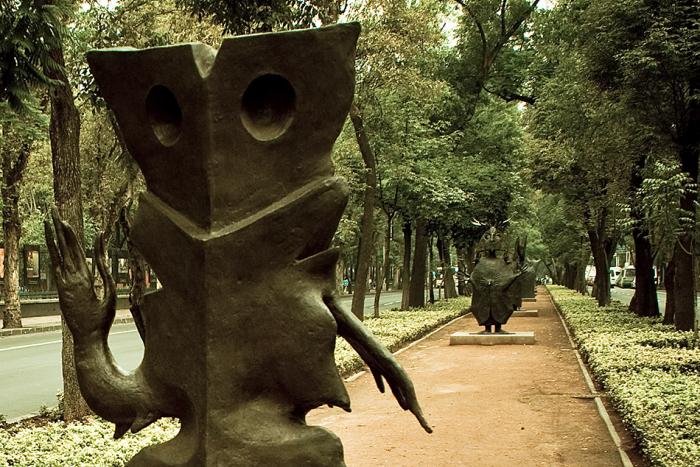It is scientific fact that some forests just have to burn. In North America’s dry, western forests, regular fires are necessary and preventative. They reduce the amount of fuel available to a bolt of lightning or an arsonist, thus decreasing the likelihood of inadvertent or otherwise deadly conflagration. They can cut down on pests, burning off the sanctuaries of dead trees and diseased plants. Those burned-out carcasses of our botanical elders can then, by that same token, serve as refuge for nesting birds and skittish mammals.
But such fires do not just protect: they are, in their spectacular violence, a way for the forest to rejuvenate itself. They can help stave off the creeping spread of invasive plants that compete with the local flora, which often fails to return after the ash has settled, leaving behind space and sunlight and sought-after soil nutrients for those adapted to stay. The ash, too, is a conspirator in this rebirth, a Robin Hood to what remains, burning some and spreading the wealth of sequestered nutrition back into the soil to be used by many.
And then there are the seeds.
There is a phenomenon in botany known as serotiny. It describes an adaptation in certain plants in which the release of seeds requires an environmental trigger, be it the death of the parent plant or the addition of moisture. When the release of seeds is contingent upon fire, it is known as pyriscence. The great Sequoias of Yosemite are pyriscent. In order for one of these gentle towers to start its life cycle anew, there must be flame. It is a true phoenix; it is of the ashes.
But just because a forest is built to burn, or needs to burn, or is desperately trying its goddamn hardest to transform itself through combustion and kindling, it doesn’t mean the process is benign. Destruction may be necessary, but it is not particularly pleasant. Consider the caterpillar, its insides turning to soup, cramped inside a coffin of its own making.
I think a lot about those forests burning. I wonder if the trees are screaming. I wonder where the birds go. I wonder how on earth anything could ever escape an inferno, never mind find within the wreckage the raw materials of rebuilding.
I think about my marriage.
*
I know now that I made my home in a volatile forest. I loved those woods, and for seven years found solace there, huddled in the overgrowth of an untended underbrush, scaling the ancient trees to the illusion of safety, working tirelessly to save each sapling and bush hearty enough to bury its roots in our fertile soil. It was a beautiful, joyous place when there was joy to be had, but it was not safe, and more often than not I suffered and cowered. Living there required a certain kind of brokenness, that I should supplicate myself to allay the fears of another. But I am wild, and this was untenable.
I was so busy trying to survive the untenable ecosystem of my marriage—so deeply protective of the vast expanse in which I’d built my life—that I couldn’t see it. My forest, my beloved forest, needed to burn. All my strangled protestations and daily rituals would—and did—eventually falter.
But making a forest wait to burn only makes the inevitable fire bigger. And when the fire came—the big one—I fought it.
I fought back with buckets of water, with hoses, with helicopters fat with foamy fire retardants. I ran into the thick of it, naked and frantic, breathing hard and smelling the acrid aftermath of my soft, blonde body hair, burnt away by the flames that licked my exposed skin. Unable to let go, I developed ominous burns on my fingertips that swelled to rose-colored grapes then shrank into thick, black scabs that cracked underneath like tortoiseshell. Years of “Only You Can Prevent Forest Fires” would ring in my ears, the worn devotional that brought me back into the forest again and again and again.
In the early days of his reign, Smokey Bear informed the public that western wildfires were mainly the fault of humans. In fact, while there are between six and ten human-caused blazes in Yellowstone National Park annually, lightning is responsible for around thirty-five fires there a year. But as everyone knows, the siren call of “help me” is the most seductive of cries.
I alone could not stop my forest from burning and I was a fool to try.
*
In the early twentieth century, there was a fire that changed everything. Known as the “Big Blowup,” the Great Fire of 1910 burned an area the size of Connecticut clean through Washington, Idaho, and Montana. It got its name from the circumstances that spawned it: hurricane-force winds whipped up by a cold front that swept into the area, bringing hundreds of small fires into two towering infernos.
At the time, the burgeoning U.S. Forest Service—then the National Forest Service and on the verge of cancellation—was ill-equipped to handle the disaster. But something had to be done, of course. This is America. Prior to this burn, there had been some debate about how to deal with forest fires: Do we let them burn, or should we put them out?
It’s a familiar moment in times of chaos, a reckoning that forces us to choose the guardianship of preservation or the cool remove of letting nature take its course. The NPS chose to fight, a decision not without consequence: the blaze, the largest in history, roared for two days and killed eighty-seven people, the majority firefighters themselves.
When Ferdinand A. Silcox, a firefighter in the Big Blowup, became chief of the fire service, he promoted the arboreal version of “never go to bed angry”: the 10 a.m. policy. Under this protocol, the goal was to suppress every reported fire by 10 a.m. the next day. If you have ever been caught in a cycle of anger and absolution with a loved one, this technique will be immediately recognizable and ring unquestionably doomed.
The suppression began. In play by the 1940s were the smokejumpers: firefighters who would parachute into lands ablaze to quench the transformative chaos. The idea was that the smokejumpers would fall from the sky into remote wilderness, showing up to smother the early flames before they could burn the forest proper.
But twenty years after the ban on fires became written mandate, one glaring aside became too noisy to ignore: there were no new giant sequoias growing in the forest. Fire suppression, we were learning, had not protected the forests—it had muzzled them.
In the early 1960s, Dr. Richard Hartesveldt was studying the curious link between fire and sequoia regeneration. After nearly a century of fire suppression in the western United States, his small-scale prescribed burns brought about the germination of sequoias and the recruitment of their seedlings. As Dr. Hartesveldt so deftly demonstrated, these venerable conifers needed their pine cones to feel the oven blast of flames before their seeds would be released. They needed the rich nutrient ash of freshly scalded forest to nurture their young. Without the open canopy of a scorched landscape to welcome them into the sky, their babies would never become great.
His findings were the precursor to the 1963 Leopold Report, the product of an advisory panel helmed by the document’s namesake, Dr. Starker Leopold, who’d been appointed by the Secretary of the Interior to weigh in on how we should tend our forests. The report was clear: we should manage our ecosystems in a way that most closely accords with the native needs of our natural systems. We had to make space for fire.
*
Sometimes we wait for flames and let them smolder, and sometimes we set the fires ourselves. These are prescribed burns. When I was a wee field researcher running around Florida scrub lands, gripping a clipboard and sunscreen with equal desperation, I got to see one close up.
Do not let the tepid jargon fool you: prescribed burns are revelatory to behold.
A short walk from the rustic cabin at the Tall Timbers Research station that was my temporary home was the edge of the blaze. As I got closer, the hot winds of flame pushed back against my skin ever so slightly, parting the stagnant air of a wet, Southern afternoon in June. Before me, men in sturdy garments wielded flame throwers, torching the ground with a wholly unnerving nonchalance. The grass took to combustion with great enthusiasm, sparking up into oranges and reds and yellows before lapping away from us at the whims of the winds we knew were blowing. A wall of flames engulfed the forest, climbing the dried vines as they climbed the trees, crackling and roaring and shrieking an atonal distress signal. Birds flew out of the apocalypse, lit from behind by a palette best suited for Samhain or Michael Bay.
It is a word we use with bored remove, but I mean it in earnest when I say that the sight was awesome. I was terrified, overwhelmed, the precursor to tears burning my eyes as acutely as the purpled smoke snaking through the air. We did this, we started this, this is on our hands—but it was necessary. Pale white ash floated down from the sky, catching the fibers of my quick-dry field clothes like wintery precipitation on cold eyelashes. It was snowing in Florida. I knew what we were doing needed to be done, but it felt like I was party to a crime of expansive cruelty all the same.
It felt like a breakup.
*
The implosion of my marriage, however, was not so deliberate or predictable. This fire wasn’t planned alongside a careful adjudication of how the winds were blowing, and it certainly wasn’t a calculus presented by a team of seasoned professionals. This blaze was borne of the age of fire suppression: long overdue and packed with more fuel than anyone knew how to control. It was devastation writ large, a biblical imagining of what two people could conjure. It was the end of something.
Was he the forest and I merely a visitor to his lands, ill-suited to weather the unpredictable but ultimately cyclic nature of his needs? Or was I the forest, a taciturn box of tinder playing with a book of matches, staving off the end of a painful chapter by stamping my feet on the sparks?
A quiet part of me suspects that perhaps we together were the forest, the nature of our twin efforts as spectacular and inviting as they were doomed and unsustainable. Maybe if we’d let it burn back when it first needed to, we could have avoided such a terrible blaze. Maybe we would have even withstood the heat, resowed the seeds of intention and blind optimism and regrown together, stronger and healthier than before. But the forest of my marriage was not the healthy, wet ecosystem of the Appalachian temperate rainforest—it was an arid expanse screaming for rain, littered with downed trees full of pith that crumbled between the fingers.
Our forest was packed with nature’s dynamite.
We don’t always get to choose our roles in this cycle of destruction and rebirth, but I think I’d like to be a pyriscent seed: free to be carted off by a careless wind or a hungry squirrel, marked by the flames of my beloved forest burning, ready to settle into healing fallen ash. It could be that the forest I loved so dearly would never have been conducive to my growth. Maybe now is the time to find a soft expanse of nurturing soil and unfettered sunlight. At long last, maybe now is when I unfurl the first tender leaves of autonomy and lay roots in a solitary, skyward existence of my very own.






